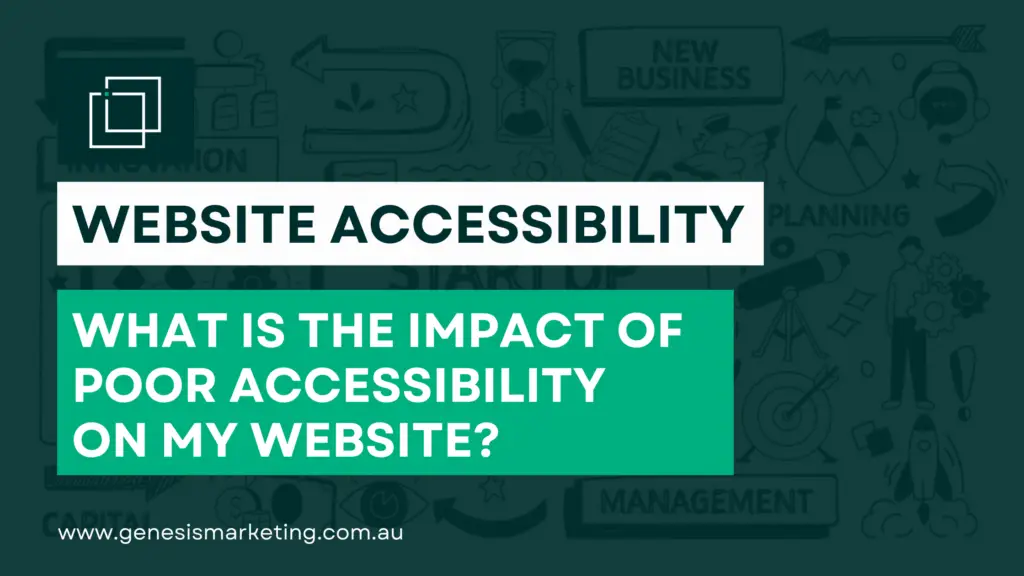What is the Impact of Poor Accessibility on my Website?
Google uses a plethora of factors when ranking your website for search results.
Accessibility is one that Google finds hard to measure because it’s difficult to index.
However, this doesn’t mean that having poor accessibility on your site won’t impact your rankings!
Your accessibility contributes to your user experience (UX), and this plays a big role in your SERPs.
Making your website accessible is a priority not only for including your entire target market but also for your website’s overall performance.
How Do I Know If My Website Is Accessible?
It is a good idea to become versed with the Website Content Accessibility Standards (WCAG).
These standards provide web designers and businesses with a framework for making web content accessible to people with disabilities.
This takes the guesswork out of making your website accessible while in the design phase.
Common errors that will create barriers for some segments of your audience are:
- Dynamic content like pop-ups can confuse screen readers.
- Low contrast between background and text colour limiting visibility and readability.
- Tables with increased markup can be confusing for screen readers.
- Complex nested navigation makes browsing your site arduous for those using accessibility devices.
- The text on the images is too small.
- Lack of skip-to-content links to avoid screen readers having to recite the entire menu with each new page visited.
What are the Types of Accessibility Issues?
There are 3 main classifications of accessibility issues: critical issues, serious issues, and minor issues.
Critical issues as the name suggests, are the biggest barriers to those using assistive technology to browse the internet. Essentially it means even if they had the desire to explore your web page, they won’t be able to.
Serious issues make the user experience a difficult and frustrating one for users who are either using assistive technology or that have a disability, impairment or limitation that affects the way they browse the internet.
Minor issues are those that cause frustrations and poor user experience for a small portion of your viewership.
What Impact Do These Issues Have?
Having an accessible website will place you ahead of the curve when it comes to search engine results pages (SERPs).
If you are having a large number of critical and serious issues, you are not only marginalising your audience, but you are potentially damaging your rankings.
The aim of the game is to have your website landing in the top few results when a user starts searching for a product or service that falls within your niche.
Should you have consistently poor user experience and ongoing critical accessibility issues, you are likely to impact where Google ranks you in these search results.
An accessible website ensures that all your potential audience, including those with disabilities, have a positive user experience, and have access to all your content and business information.
This will increase traffic and brand visibility because you are not excluding any segment of your potential market.
By adhering to accessibility best practices, not only are you catering to those who face barriers when browsing the web, but you are also improving the ease and usability of your site for all users.
Steps for Accessibility Best Practice
- Ensure your website software or content management system prioritise accessibility. This will make it easier for you to maximise accessibility features.
- Add descriptive alt text to your images. This lets users with screen readers understand the image and its relation to the page content. Optimise your images to improve SEO ranking.
- Use simple structure in your page content, and your website navigation. This makes it easier for screen readers to make their way through your site in a logical manner.
- Use descriptive text for your link anchor text. This lets users know exactly what to expect when clicking on the hyperlink. This is applicable to both internal and external links.
These are simple ways to improve the accessibility of your website and ensure that it is usable for all of your potential audience.
Image optimisation tools
Image size and quality
Pixlr: Use this free tool to edit images, and to increase or decrease JPEG file size or quality.
ImageOptim: Decrease file size by compressing your images without losing quality with this tool. (Mac only)
Kraken: Upload your images in bulk, compress them all at once, and download them as a zip file to save time.
WordPress Plugins
Yoast SEO: Optimise your image SEO and site accessibility by automatically assigning an alt attribute.
ShortPixel: Optimise your image size within WordPress
EWWW Image Optimizer: Automatically optimise images when they’re uploaded to your site.


